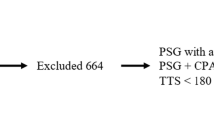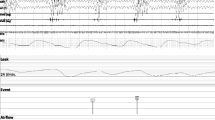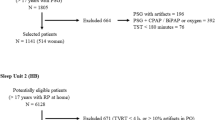Abstract
Introduction
Obstructive sleep apnea (OSA) is common, and diagnosis requires expensive and laborious testing to assess the apnea hypopnea index (AHI). We performed an analysis to explore the relationship between the oxygen desaturation index (ODI) as measured with pulse oximetry and the AHI in our large portable monitoring (PM) database to find an optimal cutoff value for the ODI in order to be able to exclude AHI ≥ 5 on PM.
Methods
Three thousand four hundred thirteen PM recordings were randomly divided into a training set (N = 2281) and a test set (N = 1132). The optimal cutoff for the ODI to exclude an AHI ≥ 5 on PM was determined in the training set and subsequently validated in the test set.
Results
Area under the curve of the ODI to exclude an AHI ≥ 5 on PM was 0.997 in the training set and 0.996 in the test set. In the training set, the optimal cutoff to predict an AHI < 5 was an ODI < 5. Using this cutoff in the test set provided a sensitivity of 97.7%, a specificity of 97.0%, a positive predictive value of 99.2%, and a negative predictive value of 91.4%.
Conclusion
An ODI < 5 predicts an AHI < 5 with high sensitivity and specificity when measured simultaneously using the same oximeter during PM recording.


Similar content being viewed by others
References
Young T, Palta M, Dempsey J, Skatrud J, Weber S, Badr S (1993) The occurrence of sleep-disordered breathing among middle-aged adults. N Engl J Med 328:1230–1235
Peppard PE, Young T, Barnet JH, Palta M, Hagen EW, Hla KM (2013) Increased prevalence of sleep-disordered breathing in adults. Am J Epidemiol 177:1006–1014
Eijsvogel MM, Wiegersma S, Randerath W, Verbraecken J, Wegter-Hilbers E, van der Palen J (2016) Obstructive sleep apnea syndrome in company workers: development of a two-step screening strategy with a new questionnaire. J Clin Sleep Med 12:555–564
Franklin KA, Lindberg E (2015) Obstructive sleep apnea is a common disorder in the population—a review on the epidemiology of sleep apnea. J Thorac Dis 7:1311–1322
Collop NA, Anderson WM, Boehlecke B, Claman D, Goldberg R, Gottlieb DJ, Hudgel D, Sateia M, Schwab R (2007) Clinical guidelines for the use of unattended portable monitors in the diagnosis of obstructive sleep apnea in adult patients. Portable Monitoring Task Force of the American Academy of Sleep Medicine. J Clin Sleep Med 3:737–747
Ramachandran SK, Josephs LA (2009) A meta-analysis of clinical screening tests for obstructive sleep apnea. Anesthesiology 110:928–939
Abrishami A, Khajehdehi A, Chung F (2010) A systematic review of screening questionnaires for obstructive sleep apnea. Can J Anaesth 57:423–438
Nigro CA, Dibur E, Rhodius E (2011) Pulse oximetry for the detection of obstructive sleep apnea syndrome: can the memory capacity of oxygen saturation influence their diagnostic accuracy? Sleep Disord 2011:427028
Hang L-W, Wang H-L, Chen J-H, Hsu J-C, Lin H-H, Chung W-S, Chen Y-F (2015) Validation of overnight oximetry to diagnose patients with moderate to severe obstructive sleep apnea. BMC Pulm Med 15:24
Chung F, Liao P, Elsaid H, Islam S, Shapiro CM, Sun Y (2012) Oxygen desaturation index from nocturnal oximetry: a sensitive and specific tool to detect sleep-disordered breathing in surgical patients. Anesth Analg 114:993–1000
Kunisaki KM, Bohn OA, Wetherbee EE, Rector TS (2016) High-resolution wrist-worn overnight oximetry has high positive predictive value for obstructive sleep apnea in a sleep study referral population. Sleep Breath 20:583–587
Collop NA, Tracy SL, Kapur V, Mehra R, Kuhlmann D, Fleishman SA, Ojile JM (2011) Obstructive sleep apnea devices for out-of-center (OOC) testing: technology evaluation. J Clin Sleep Med 7:531–548
Berry RB, Budhiraja R, Gottlieb DJ, Gozal D, Iber C, Kapur VK, Marcus CL, Mehra R, Parthasarathy S, Quan SF, Redline S, Strohl KP, Davidson Ward SL, Tangredi MM, American Academy of Sleep Medicine (2012) Rules for scoring respiratory events in sleep: update of the 2007 AASM manual for the scoring of sleep and associated events. J Clin Sleep Med 8:597–619
Chai-Coetzer CL, Antic NA, Hamilton GS, McArdle N, Wong K, Yee BJ, Yeo A, Ratnavadivel R, Naughton MT, Roebuck T, Woodman R, McEvoy RD (2017) Physician decision making and clinical outcomes with laboratory polysomnography or limited-channel sleep studies for obstructive sleep apnea: a randomized trial. Ann Intern Med 166:332–340
Corral J, Sánchez-Quiroga MÁ, Carmona-Bernal C, Sánchez-Armengol Á, de la Torre AS, Durán-Cantolla J, Egea CJ, Salord N, Monasterio C, Terán J, Alonso-Alvarez ML, Muñoz-Méndez J, Arias EM, Cabello M, Montserrat JM, de la Peña M, Serrano JC, Barbe F, Masa JF, for the Spanish Sleep Network (2017) Conventional polysomnography is not necessary for the management of most patients with suspected obstructive sleep apnea. Noninferiority, randomized controlled trial. Am J Respir Crit Care Med 196:1181–1190
Kapur VK, Auckley DH, Chowdhuri S, Kuhlmann DC, Mehra R, Ramar K, Harrod CG (2017) Clinical practice guideline for diagnostic testing for adult obstructive sleep apnea: an American Academy of Sleep Medicine clinical practice guideline. J Clin Sleep Med 13:479–504
Chai-Coetzer CL, Antic NA, Rowland LS, Reed RL, Esterman A, Catcheside PG, Eckermann S, Vowles N, Williams H, Dunn S, McEvoy RD (2013) Primary care vs specialist sleep center management of obstructive sleep apnea and daytime sleepiness and quality of life: a randomized trial. JAMA 309:997–1004
Dawson A, Loving RT, Gordon RM, Abel SL, Loewy D, Kripke DF, Kline LE (2015) Type III home sleep testing versus pulse oximetry: is the respiratory disturbance index better than the oxygen desaturation index to predict the apnoea-hypopnoea index measured during laboratory polysomnography? BMJ Open 5:e007956
Ling IT, James AL, Hillman DR (2012) Interrelationships between body mass, oxygen desaturation, and apnea-hypopnea indices in a sleep clinic population. Sleep 35:89–96
Feiner JR, Severinghaus JW, Bickler PE (2007) Dark skin decreases the accuracy of pulse oximeters at low oxygen saturation: the effects of oximeter probe type and gender. Anesth Analg 105:18–23
Davila DG, Richards KC, Marshall BL, O’Sullivan PS, Osbahr LA, Huddleston RB, Jordan JC (2003) Oximeter’s acquisition parameter influences the profile of respiratory disturbances. Sleep 26:91–95
Cross TJ, Keller-ross M, Issa A, Wentz R, Taylor B, Johnson B (2015) The impact of averaging window length on the “ desaturation ” indexes obtained via overnight pulse oximetry at high altitude. Sleep 38:1331–1334
Gumb T, Twumasi A, Alimokhtari S, Perez A, Black K, Rapoport DM, Sunderram J, Ayappa I (2017) Comparison of two home sleep testing devices with different strategies for diagnosis of OSA. Sleep Breath:1–9
Guilleminault C, Hagen CC, Huynh NT (2009) Comparison of hypopnea definitions in lean patients with known obstructive sleep apnea hypopnea syndrome (OSAHS). Sleep Breath 13:341–347
Ruehland WR, Rochford PD, O’Donoghue FJ, Pierce RJ, Singh P, Thornton AT (2009) The new AASM criteria for scoring hypopneas: impact on the apnea hypopnea index. Sleep 32:150–157
Malhotra A, Orr JE, Owens RL (2015) On the cutting edge of obstructive sleep apnoea: where next? Lancet Respir Med 3:397–403
Author information
Authors and Affiliations
Contributions
TF contributed to the design, analysis of the data, interpretation of the data, and writing of the manuscript and takes full responsibility for the content of the manuscript, including the data and analysis; JB contributed to the design, data extraction, analysis of the data, and critical revision of the manuscript; LB contributed to the design, analysis of the data, and writing of the manuscript. JvdP contributed to the design, statistical analysis, interpretation of the data, and critical revision of the manuscript; FdJ contributed to the design, interpretation of the data, and critical revision of the manuscript; ME contributed to the design, data collection, interpretation of the data, and critical revision of the manuscript.
Corresponding author
Ethics declarations
Conflict of interest
JB reports shares in DiagnOSAS B.V., a company that aims to facilitate screening for sleep apnea in a primary care setting. All other authors (TF, LB, JvdP, FdJ, and ME) certify that they have no affiliations with or involvement in any organization or entity with any financial interest (such as honoraria; educational grants; participation in speakers’ bureaus; membership, employment, consultancies, stock ownership, or other equity interest; and expert testimony or patent-licensing arrangements), or non-financial interest (such as personal or professional relationships, affiliations, knowledge, or beliefs) in the subject matter or materials discussed in this manuscript.
Ethical approval
All procedures performed in studies involving human participants were in accordance with the ethical standards of the institutional and/or national research committee and with the 1964 Helsinki declaration and its later amendments or comparable ethical standards. Both the local ethics committee and the board of directors of the Medisch Spectrum Twente approved the study protocol.
Informed consent
This study is based on anonymous data. Therefore, obtaining informed consent was deemed unnecessary (as approved by the local ethics committee).
Additional information
Prior publication
An abstract of this research was presented as a thematic poster during the 2016 ERS congress.
Rights and permissions
About this article
Cite this article
Fabius, T.M., Benistant, J.R., Bekkedam, L. et al. Validation of the oxygen desaturation index in the diagnostic workup of obstructive sleep apnea. Sleep Breath 23, 57–63 (2019). https://doi.org/10.1007/s11325-018-1654-2
Received:
Revised:
Accepted:
Published:
Issue Date:
DOI: https://doi.org/10.1007/s11325-018-1654-2




